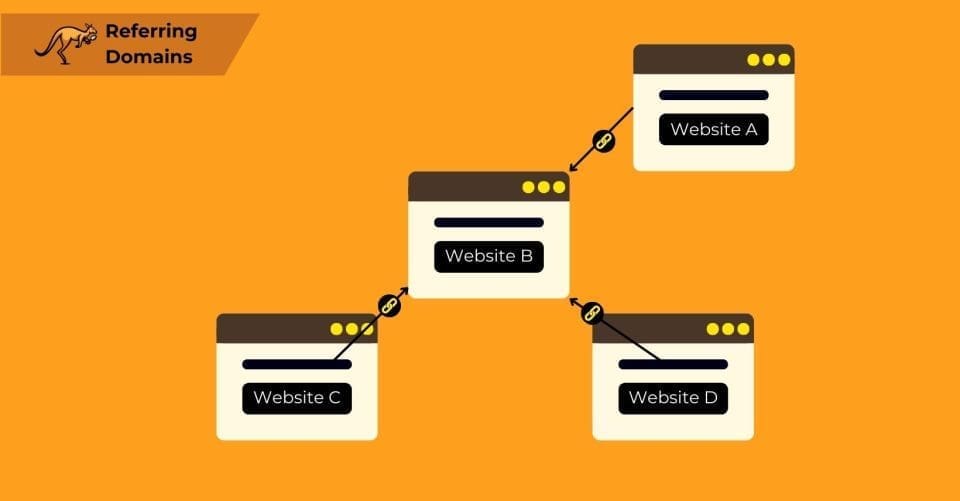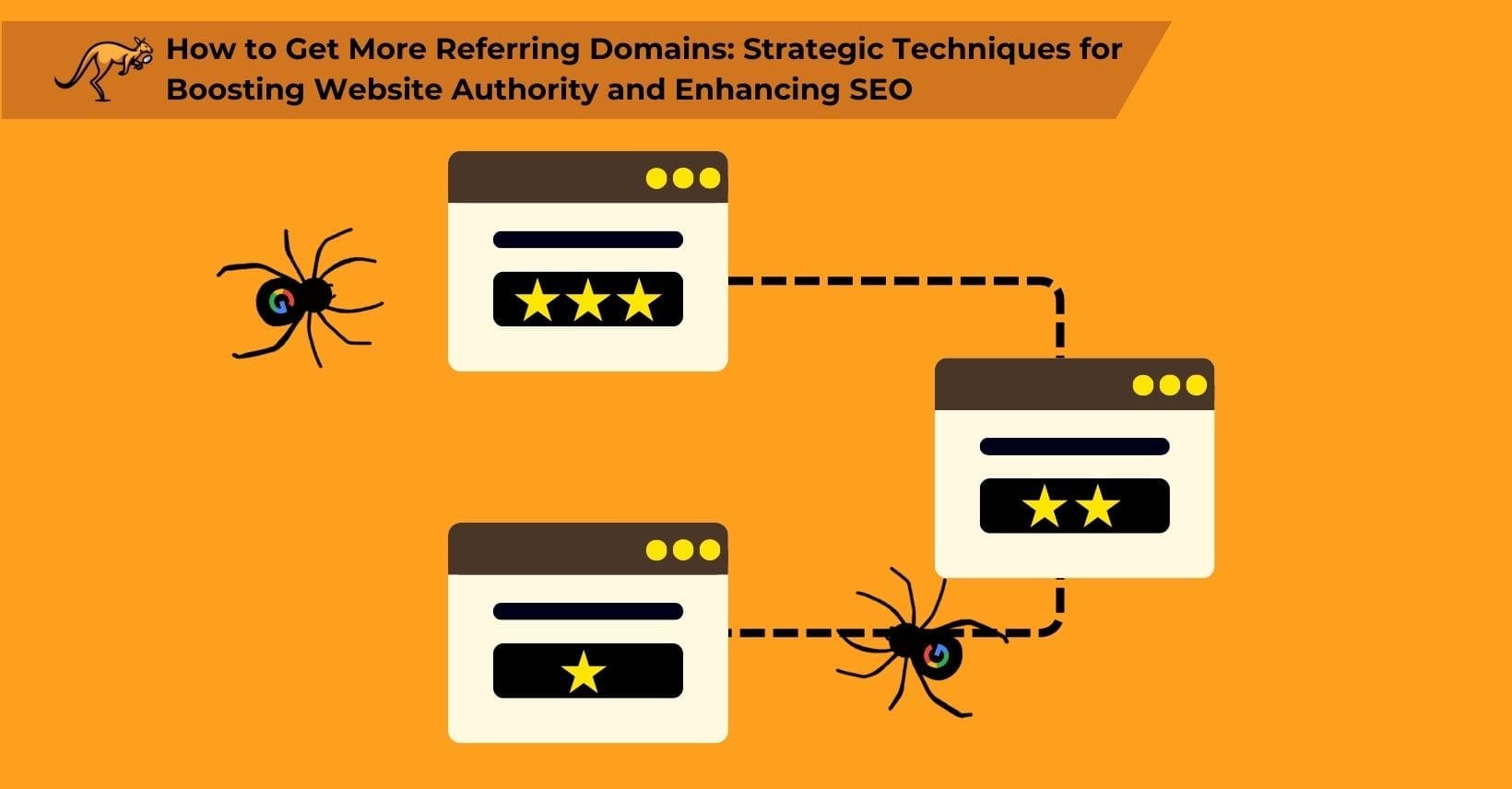More referring domains can dramatically boost your search engine optimization (SEO) results and your rankings in search engines.
However, for a relative SEO newbie, getting additional referring domains can seem very tricky.
What do a website’s referring domains do, and how can you get more referring domains linking back to your website?
What are Referring Domains?

Referring (also called linking domains) are websites that link to your site through external hyperlinks, which serve as digital endorsements that search engines use to evaluate your website’s credibility and relevance.
High-quality backlinks from relevant sites directly enhance your SEO because referring domains act as trust signals that increase your website’s authority score, making it beneficial to secure as many of these links as possible, provided they align with your site’s content.
This strategic linking underlines the importance of understanding these connections’ fundamental roles. Now, let’s explain the purpose and utility of backlinks and referring domains, setting the stage for a deeper exploration of their important roles in SEO.
What are Backlinks and Referring Domains For?
Backlinks are used to boost your ranking in search engines, allowing you to appear higher in search results for relevant search terms.
Since more referring domains mean more backlinks, seeking out new referring domains is a core part of handling SEO.
Securing high-quality backlinks and referring domains enhances your site’s credibility and SEO, boosting visibility and search rankings above competitors. This strategic improvement targets your audience more effectively and solidifies your online presence.
Such benefits underscore the importance of expanding your network of referring domains. Now, let’s explore actionable strategies for increasing the number of beneficial referring domains, ensuring sustained growth and enhanced online authority.
How Can You Get More Referring Domains?
Referring domains originate from two primary sources: natural links and deliberate link-building efforts. Natural links occur when external sites link to your content organically, whereas link-building is a strategic approach to creating additional linking opportunities for your website.
Understanding these sources is important for expanding your site’s backlink profile. In our section on ways to get more referring domains, we’ll explore various methods to enhance this process, noting that referring domains count each unique website linking to you, while referring pages count every individual page that contains a link to your site, even if multiple pages come from the same domain.
Creating Valuable Content
Most search engines prefer it when backlinks point to relevant and useful content, and most referring websites want to avoid linking to questionable or useless websites.
By producing worthwhile content, you can successfully approach more potential domains while also getting a higher chance of earning new linking domains naturally.
The more useful your content is, the more likely others are to refer to it. Even passively gaining referring domains through your content can boost your search engine rankings in the long term.
Share Your Content
If your content already exists and is not getting noticed, then finding ways to share it around can bolster your link building campaign. For example, reaching out to other blog sites to write companion articles or to promote your content can get a lot more eyes on it.
Of course, this should ideally only be a temporary solution. Doing this too much can seem like spam, which might get your web page (or entire site) penalized by search engines.
Target Content Gaps
If you are competing with a lot of other companies in the same industry, try to find niches that have not been filled by other websites already.
For example, a simple how-to tutorial on a complex process can get a lot of organic traffic and useful links and might establish you as an authority within that niche.
Building Links
If you want to get additional referring domains directly, then you can always manually build them. A good link building strategy usually focuses on arranging for custom links on high-quality referring domains.
With link building, you can contact website owners and arrange for guest posts (or even ask them to write blog posts promoting something you sell) to get more links. This gives you some control over how those websites link to your own site.
Of course, these external websites have to agree to this, and many may not accept a link placement. Others may demand at least some control over the content, which can lead to less-than-optimal links.
Guest Posts
Placing guest content on a blog post related to your target audience is a great way to gather more relevant links.
As long as these other websites are in the same general niche or focused on the same topic, any guest blog post links you get will provide SEO benefits.
A guest post also allows you to adjust how the content is written, which can really help if you want to use a distinct keyword on that linking domain.
Other Link Placements
Between dead link building (replacing dead links on other websites with links to your own) and various other unconventional link building strategies, there are a lot of ways to attract more links by talking with site owners.
The most popular referring domains in your niche may have very strict standards on which posts they will accept or even the sites that they will work with.
Finding Opportunities

If you are not sure how to get more referring domains, then you need to start looking for useful opportunities that can provide referring domains for you.
For example, you can analyze domains reports in analytics software like Ahrefs to get a breakdown of your website’s search engine rankings, leading referring domains, highly relevant sites, and various ways to target web pages that might make useful future referring domains.
New Links
Even a single referring domain can be an opportunity worth taking, and several referring domains at once are even better.
A good backlink strategy relies on a constant flow of potential domains. You ideally want to acquire referring domains as often as you discover new ones, so tracking down more is important.
You can round up posts and sites that are relevant to your niche, seek out high-quality content related to your industry, or just analyze referring domains report information to find new sites for your link building strategy.
Link Optimization
Your referring domains report can also show you referring domains and backlinks that are not performing well or that are actively damaging your rankings.
Part of your link building efforts should involve either fixing or removing these domains, depending on whether they are causing problems or not. One referring domain having a negative impact might not hurt your rankings much, but ten is a serious problem.
With underperforming referral domain options, you can always try placing a new and more relevant link on the same domain.
Copy Competitors
If all else fails, you can simply copy a number of referring domains from your competitors. If your referring domain strategy does not already use many of the same links as them, you can simply replicate their success to boost yourself higher.
Increasing referring domains boosts website traffic by improving search engine rankings, diversifying traffic sources, establishing your site as an authority, and creating multiple entry points for visitors, though acquiring links from these domains can be challenging as not all are open to linking to your site. Understanding this, it becomes important to adopt effective strategies that convince other domains to link to yours.
Now, let’s explore powerful methods in our next section, How to Capture New Referring Domains Effectively, where we’ll delve into practical tactics to secure valuable new links and expand your web presence strategically.
How to Capture New Referring Domains Effectively
Securing high-quality referring domains is essential for enhancing your site’s authority. These valuable domains, often coveted for their domain authority, can be challenging to acquire due to high competition.
Effective strategies are important to successfully engage these domains and leverage their potential for boosting your SEO. This leads us to explore tactics designed to optimize this process. Next, we’ll delve into various ways to capture new referring domains effectively, ensuring your website gains the authoritative backing it needs to excel.
Identify Good Referring Domains
Identify high-quality referring domain opportunities by examining domain authority metrics, relevance to your niche, and traffic statistics in your referring domain report, and use specialized SEO tools to analyze each potential referring domain you find.
If you want more organic traffic, better rankings, and a stronger link profile, then you want to target authoritative domains that are relevant to your niche.
Watch Potential Domains
Track prospective referring domains that you are not approaching straight away. You want to know which potential referring domains you can pursue if you need to, even ones that are already referring domains for other websites in your industry.
Referring Domains Vs Backlinks
Both referring domains and backlinks are important in SEO strategy, but referring domains represent unique websites linking to you while backlinks count each individual link, making referring domains a measure of your link diversity and backlinks a measure of your total link quantity.
Even the most relevant referring domains can be pointless if you are not using those linking domains well, such as linking to irrelevant web pages or using anchor text that does not suit your target audience.
Use White Hat Methods
Never go against search engine guidelines while trying to boost your site’s backlink profile. Securing one or more backlinks is never worth the potential penalties.
Black-hat methods can get your entire site structure deindexed for a while, meaning that you will not rank at all.
Check Referring Domains’ Limits
Not all potential referring domain sites will accept certain types of link building.
If possible, try to understand what the site will accept beforehand so that you do not start off on the wrong foot. A show of respect can actually increase the chances of them working with you.
Use Online Services
There is no shame in using a free service website to sort through referring pages or throw together a quick backlinks report.
Any tool that helps in finding and understanding referring domains can be invaluable, even if it is just the free trial of an online tool that you have no intention of paying for straight away.
Pay Attention to Traffic
Not all referring domain links need to be purely for SEO. Sometimes, it is worth getting a link that is likely to bring in organic user traffic from the target site itself.
While organic search traffic through SEO is still better, sometimes securing a simple link for added sales can be worthwhile, especially for a smaller company that needs all of the customers it can get.
Track Referring Domains
Track referring domain growth by monitoring secured referring domains through SEO analytics platforms that measure new acquisitions, lost links, and authority changes, allowing you to know if domain authority drops sharply or web pages that held the links disappear.
It is entirely reasonable for a number of referring domains to disappear or break over time. By keeping track of them, you can identify which referring domain disappears and decide whether or not to pursue the site for another link to replace it.
Choose Numbers Over Assumptions
Always look at hard data, like domain authority, before making a decision. Each referral domain is special, but some are going to be objectively more useful or worthwhile than others.
If you have a number of referring domains to choose from as prospective link targets, then make sure you are choosing them based on their actual value rather than making assumptions regarding which one would be a stronger link option.
Use Each Referring Domain Well
When optimizing your website for increased referring domains, it’s important not to misuse link opportunities by repurposing unrelated content. Instead, tailor your content and links to align perfectly with each prospective site, ensuring they are both relevant and beneficial. This approach maximizes the effectiveness of each domain, enhancing your overall linking strategy.
Creating high-quality, site-specific content ensures that every link serves its purpose, contributing to a stronger SEO profile. Understanding this need for strategies, let’s explore why choosing Searcharoo to manage your referring domains can provide the precision and expertise needed to expand your online presence effectively.
Why Choose Searcharoo to Get More Referring Domains
Choosing Searcharoo to enhance your strategy for acquiring more referring domains means selecting a partner that understands the intricacies of SEO and the importance of quality link-building. Searcharoo identifies and secures high-quality referring domains that align perfectly with your content and SEO goals. They focus on sustainable, white-hat strategies to effectively increase your website’s authority and search engine ranking.
Their SEO experts use advanced tools and analytics to pinpoint the most beneficial opportunities for your site, ensuring that each referring domain adds value and supports your overall digital marketing objectives. With Searcharoo, you can access customized strategies, ongoing support, and the expertise necessary to make the most out of every link, boosting your visibility and driving more organic traffic to your site.
Opt for Searcharoo to ensure your linking strategy is effective and created to your special needs and goals. Now, let’s explore how you can benefit most from your linking domains, ensuring that each connection effectively supports your broader digital marketing goals.
Benefiting From Your Linking Domains
Search Engine Optimization has many different strategies and techniques associated with it, and building links is one of the most famous.
Good link building can allow your site to see massive SEO improvements and general growth without costing you as much money as a regular ad campaign would, all while having a lot of control over how you improve in search rankings.
Using Search Engine Optimization effectively can be difficult at first, but learning the specifics makes it much easier. The more you know about SEO, the easier it becomes to optimize your site until you are receiving incredibly strong benefits from your incoming links.
Take your time to carefully evaluate each linking opportunity before committing. Hastily formed links can lead to SEO errors that might compromise your site’s ranking. It’s crucial to approach each potential backlink with caution, especially if you’re new to the nuances of SEO.
You can find detailed guides and resources here to explore what constitutes an effective referring domain thoroughly. This careful consideration is vital as we begin discussing the best practices for optimizing referral domains to enhance your SEO, which we will cover next in our summary.
Summary: Optimizing Referral Domains for Enhanced SEO
Mastering the strategic use of referring domains is essential for amplifying your website’s SEO performance. High-quality referring domains can elevate your visibility in search engine rankings, making cultivating backlinks from reputable sites crucial. You can substantially boost your site’s credibility and audience reach by creating valuable content, actively engaging in link-building activities, and utilizing targeted strategies to capture new referring domains. Implementing these methods effectively involves careful planning and execution, ensuring each link contributes positively to your SEO goals. To further refine your approach, partnering with experts like Searcharoo can provide the necessary insights and techniques to maximize the impact of your referring domains, driving important improvements in your digital marketing outcomes.





